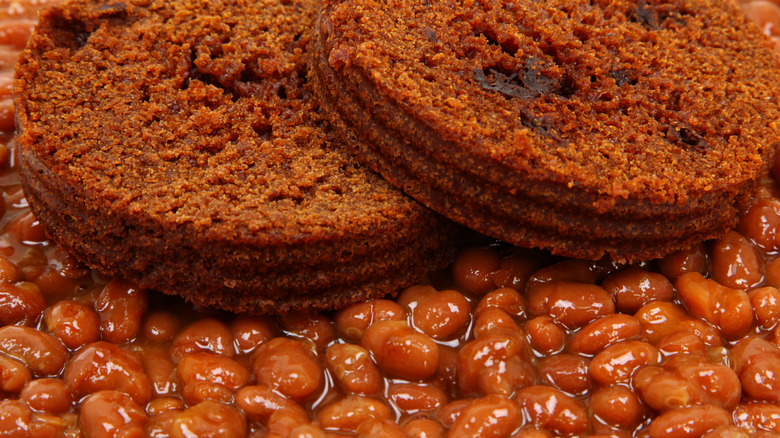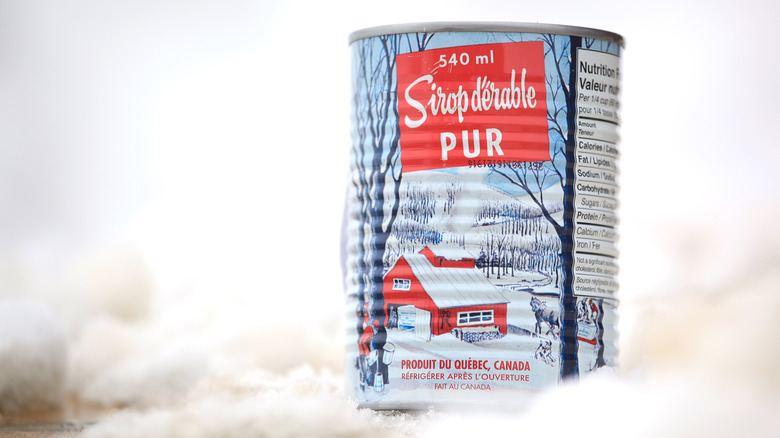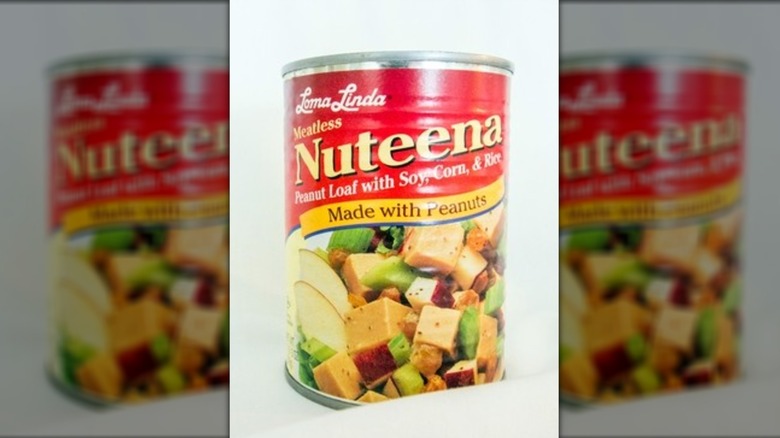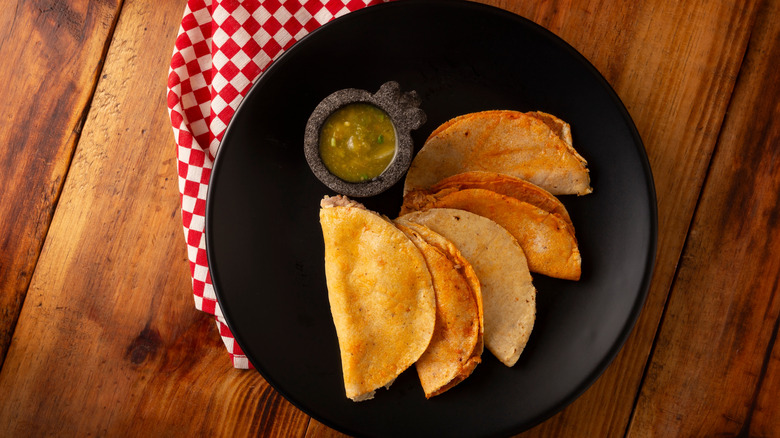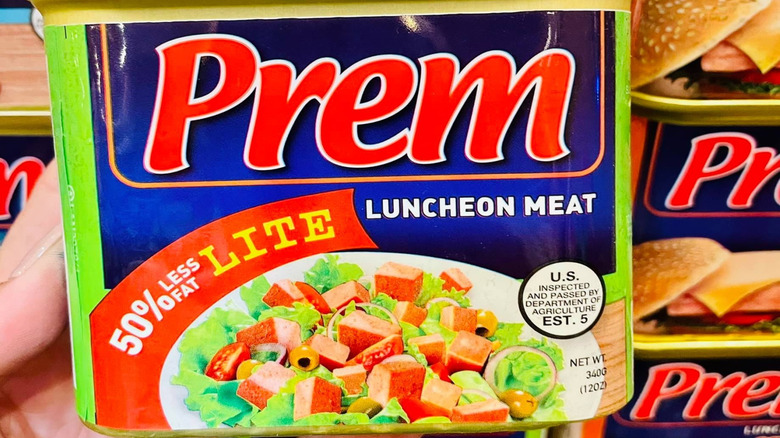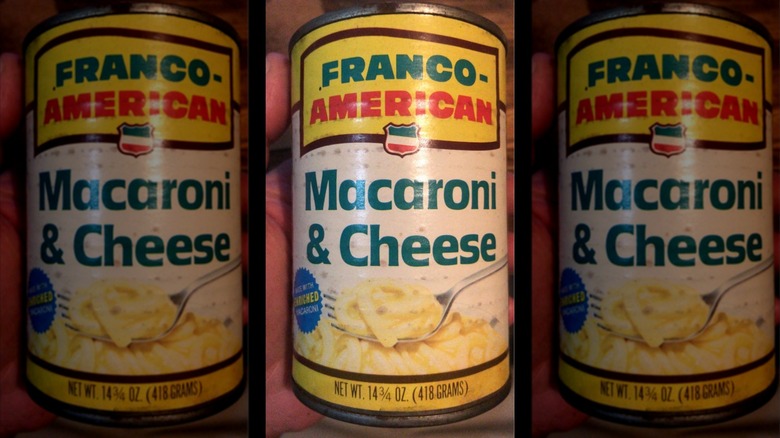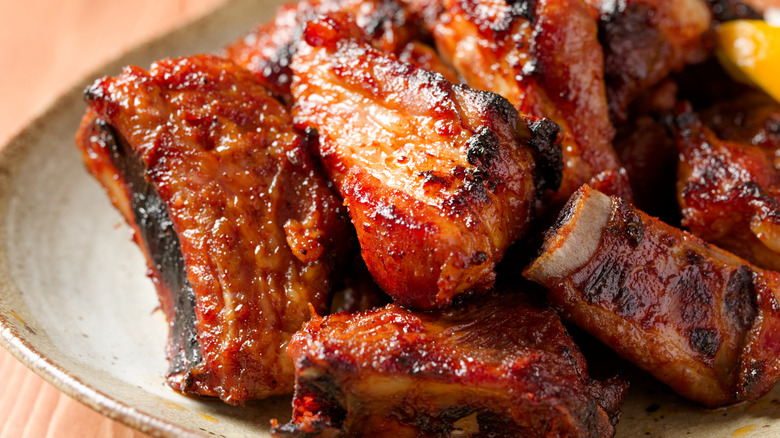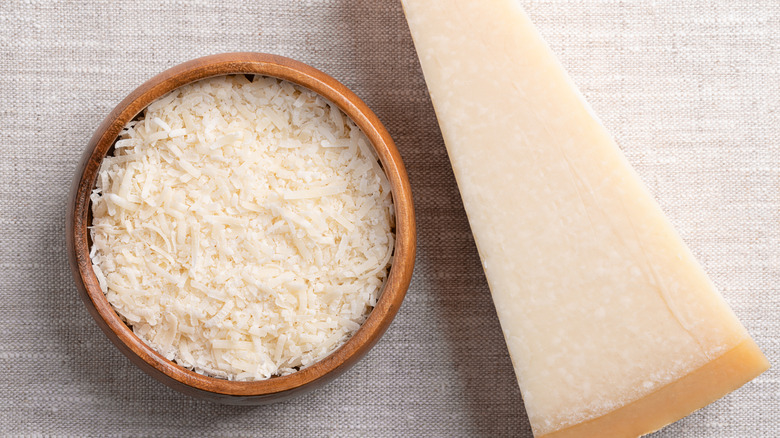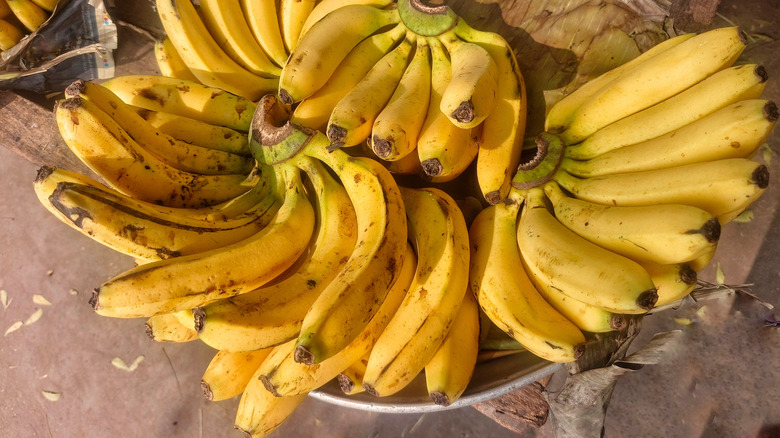Once-Popular Canned Foods Most People Don't Buy Anymore
At the end of the 18th century, the French government ran a contest, complete with a cash prize. The challenge was to invent a new way of preserving and transporting food for the French army, and the big winner was the tin can.
Like many great inventions, canning revolutionized a global system. The way we store and distribute food was forever changed, making it easier to enjoy a well-balanced diet year-round, even in extreme situations, like wartime or the dead of winter. But also like many great inventions, canning created a frenzy that was sometimes taken too far. By the mid-20th century, everything from exotic ingredients to entire ready-made meals were canned for convenience, and the results weren't always delicious. We've since learned that many foods, like fruit, should be frozen instead of canned for optimal flavor and nutrition.
While a well-stocked pantry will still feature an assortment of tin cans, and the pros and cons of canned foods vary, the method of preservation is no longer seen as a one-size-fits-all solution. Whether because they were adapted or disappeared altogether, here are 12 once-popular canned foods most people don't buy anymore.
1. Bread
In order to understand canned bread, you must first know about Boston Brown Bread, a regional delicacy that dates back to Colonial days. It's soft, a little sweet (thanks to molasses) and decidedly dense, with a cake-like texture owed to a combination of cornmeal, rye, and wheat. The dough is traditionally steamed in a mold instead of baked, which is presumably how it made its way to being canned commercially for widespread consumption.
In the 1920s, Maine-based canning company B&M introduced ready-made Boston Brown Bread in a can, available plain or with raisins. Those who'd previously been relegated to making their own were delighted to have a premade version and, for a time, canned bread was common throughout New England and beyond. A century after it hit store shelves, though, B&M Brown Bread has been largely forgotten.
If you'd like to try it, you'll be glad to know that B&M still sells its two flavors of Boston Brown Bread. Releasing it from its can takes some know-how; give it a good thwack, and it'll come out ribbed and wiggly, like a bread version of jellied cranberry sauce. For the full experience, do like nostalgic New Englanders do and top slices of the bread with Boston baked beans (also from B&M) and chopped hot dogs for a frugal, nostalgic meal.
2. Maple syrup
Production of metal food canisters accelerated after the Civil War, increasing widespread availability of many foods. With new options came new competition, and American households shifted their preference for certain ingredients, due to flavor or cost or both. One such pivot affected maple sugar, which had long been a popular sweetener. Cane sugar was cheaper, and the maple industry couldn't keep up, so instead it turned its focus to maple syrup.
While the maple syrup of the late 1800s came in large jugs, manufacturers moved to tin cans to offer smaller portions for at-home consumption. On the surface, this made sense: Canned foods were all the rage, and a smaller vessel allowed a family or individual to purchase a manageable amount. But the material was known to leave a metallic aftertaste if the syrup was left in the can for too long. Thankfully, we've since moved onto resealable glass bottles and plastic jugs that allow us to leisurely drizzle the best brands of maple syrup over time, without sacrificing the rich, sweet flavor we know and love. While it's still possible to purchase maple syrup in a tin can, it's no longer a popular pick.
3. Nuteena
These days, there's no shortage of tasty plant-based meat alternatives. In 1896, that wasn't the case. That was the year Dr. John Harvey Kellogg (yes, the guy who invented Corn Flakes) gave the United States its first commercial meat alternative, a peanut-based product he called Nuttose. Kellogg's wife, Ella, successfully marketed Nuttose as a health food, and the pair eventually rebranded the hearty, savory loaf as Nuteena.
Cans of Nuteena were sold by The Sanitarium Food Company, a company owned by the Seventh-day Adventist Church. The Sanitarium eventually became Loma Linda Foods, which continued to sell Nuteena for decades.
The early success of Nuteena can be credited with starting a trend toward plant-based eating, at least in the Western world. The combination of peanuts, soy, corn, and rice created an innovative texture that food scientists clamored to improve upon. By the 1920s, soybeans emerged as a singular protein. In the 1960s, a high-protein fungus hit the scene, and this led to the achievement of a protein-rich food. By the end of the 20th century, the competition was fierce and Nuteena's days were numbered. In 2005, it officially joined the ranks of discontinued canned foods you'll never eat again. But Loma Linda's still around, selling faux meat products like Choplets®, FriChik®, and Vegetable Skallops® by the can.
4. Oyster stew
Canned soup has withstood the test of time, but certain varieties have fallen out of fashion. A notable example is once-beloved oyster stew, a product of early settlers adapting generational recipes to local ingredients. Irish immigrants used readily available oysters instead of dried ling cod to recreate a taste of home, and a new tradition was served.
For many years, oyster stew was commonly enjoyed on Christmas Eve, when Irish-American mothers were too busy wrangling children to spend much time in the kitchen. The soup's forgiving recipe and luxurious flavor made it an obvious choice for a hectic and festive occasion. Campbell's saw an opportunity there, and launched a frozen version in the 1950s. The combination of briny oysters and diced vegetables in creamy broth flavored with a splash of dry vermouth was no longer relegated to the holiday season.
When Campbell's eventually discontinued its line of frozen soups, it introduced the canned oyster stew that Andy Warhol immortalized in his famous pop art. Despite that brush with fame, fans were dissatisfied. By the time Campbell's canned oyster stew was recalled in 2012, demand for the product had already declined. Today, the old-school soup is hard to find, canned or otherwise.
5. Tortillas
Would you believe that Old El Paso Tortillas used to come in a can? Sounds weird, right? Well, it might make sense when you learn that the brand was created by a canning company — and specifically, one of the first to can tomatoes in the United States.
Shortly after it was launched by the Mountain Pass Canning company in 1938, Old El Paso became known for bringing spicy Mexican flavors to the North American mainstream. It did so via its canning prowess, with canned beans and canned taco sauce quickly becoming the brand's most popular products. Old El Paso gradually branched out to offer more canned foods, including a bright yellow can of approximately 18 corn tortillas weighing 11 ounces that was available in stores in the 1980s.
While those with access to fresh tortillas may turn their noses up at the thought of eating tortillas from a can, the invention was a boon for American home chefs far from the border. On a nostalgic Facebook post by Texas Chronicles: History, Mystery and Adventure, one fan claims that the canned tortillas were "strangely not terrible if you were in a place where fresh tortillas could not be purchased." We'll have to take his word for it, as Old El Paso has since found better ways to package its tortillas.
6. Prem
Whether or not you like SPAM, or even understand what SPAM is made of, you can't deny its widespread popularity. Since it first hit store shelves in 1937, the canned, processed meat has seen a few competitors come and go — and outlived them all. Of those, one especially worthy rival was Prem, produced by Swift & Company.
A few short years after SPAM was launched, Swift & Company banked on its own long history of providing meats to the public (the company was first founded in 1875), when it positioned Prem as a premium — yes, that's what it was short for — alternative. This occurred in the midst of rapid expansion, when Swift & Company was quickly churning out new products: sausage and bacon, lard and butter, bouillon cubes, and even soap. It appeared the company had bounced back after any scrutiny it received in the wake of Upton Sinclair's "The Jungle," the novel that famously skewered the meatpacking industry and specifically The Union Stockyards, Swift & Company's plant.
After 150 years, Swift & Company's heyday came to an end. Before it was eventually downsized to form a subsidiary of ConAgra, the company pulled Prem from store shelves. Fortunately for lovers of ready-to-eat meat in a can, SPAM's still alive and well.
7. Mac and cheese
Before America's favorite at-home mac and cheese came in a blue box, one of the more popular options was sold by the can. It was Franco-American Macaroni with Cheese Sauce, introduced to American families by Campbell's in 1939. Like other products in the company's line-up, the mac and cheese (which actually, inexplicably, used long noodles more like spaghetti) was a quick success. Home cooks loved its reliable flavor and convenience, and a commercial featuring actress June Lockhart in a perfect TV kitchen kept it top of mind. For a time, it was a fixture of pantries nationwide.
Over the following decades, fans of the canned mac and cheese saw a few iterations, with the name eventually changed to Macaroni and Cheese. But, while it's still possible to buy mac and cheese in a can (canned food heavy hitters like Heinz and Chef Boyardee both have their own versions), the bright yellow branding of Franco-American is long gone. Today, all that remains of the discontinued Franco-American Macaroni and Cheese are a few copycat recipes, a Facebook group dedicated to reminiscing, and a change.org petition to bring it back.
8. Ribs
In the 1960s, if you were craving ribs but didn't have time to prepare them from scratch, you could simply pick up a can of Armour Star. Each featured 2 ½ pounds of spareribs that came fully smoked, sauced, and cooked. All the customer had to do was remove the meat from the can and heat it, and dinner for three to four people could be on the table in minutes.
By the mid-20th century, thanks to a thriving meatpacking industry, meat-eating Americans knew how to choose and cook good ribs, and what they are meant to taste like. For that reason, probably, Armour Star did not advertise its canned ribs as the cheapest. Instead, the brand banked on its flavor to do the selling. This may have been its first mistake.
While the best ribs take time to master, fans will say that the results warrant the wait. The time-saving benefit of Armour Star's canned ribs could not be denied, and that alone allowed the product to be quite (if not temporarily) popular — but the quality was perhaps not up to par. It was eventually discontinued.
9. Grated cheese
While not every brand's mascot is a real person, Chef Boyardee was. He was an Italian immigrant named Ettore "Hector" Boiardi and, with a trajectory that included catering President Woodrow Wilson's wedding and becoming a self-made millionaire, he was a true embodiment of the American Dream.
Boiardi's biggest claim to fame was, of course, integrating Italian flavors into American home cooking. He did this by making dishes like spaghetti and meatballs as quick and convenient as possible, and even changing his name to be more phonetically accessible as he shifted his professional focus from cooking in restaurants to creating and selling take-home versions of his greatest hits.
By the 1930s, Chef Boyardee was becoming a household name, producing more than 250,000 cans of sauce per day. As the brand grew, it introduced new products, including grated parmesan, or "Italian-style hard grating cheese," that was sold by the can. In the mid-20th century, the cheese was still novel. But as time passed and more Americans learned how to make Italian food at home, competition increased at the grocery store. Sales of Chef Boyardee's canned grated cheese flagged, and it was eventually discontinued. It's still possible to find it on secondhand sites to purchase as a collector's item, but actually eating the cheese in the can is probably not recommended.
10. Banana flakes
Surprisingly versatile and nutrient-dense, banana flakes (made by dehydrating and then pulverizing the fruit), were a common baby food in the 1960s. Once-popular brands like Kanana and Industrias Franco do Amaral marketed themselves to American mothers who served them as instant mashed bananas, straight from the can.
Banana flakes have uses beyond infant enjoyment, especially as they easily blend into smoothies and baked goods. They can be used to make muffins, cereals, snack bars and yogurt bowls, and can also be used in savory dishes like stir-fry. Banana flakes also make a decent binder in recipes that can handle a touch of sweetness, like veggie burgers. When you imagine the possibilities, it's a wonder that the ingredient hasn't made a major comeback by now.
Even if they become in-demand again, it won't be the vintage canned banana flakes of yore flying off the shelves. Kanana and Industrias Franco do Amaral have disappeared, and the banana flakes (or banana powder) sold on the market today come in bags and plastic tubs, making the canned versions feel especially nostalgic.
11. Hot dogs
Since they were introduced to the country by German immigrants in the 1860s, hot dogs have remained a fixture of American cuisine. It's hard to imagine a 4th of July celebration or backyard cookout without them, and that likely won't change anytime soon. One thing that has changed about hot dogs, though, is the preferred packaging.
In the mid-20th century, those looking for hot dogs at the grocery store typically headed to the canned food aisle, not refrigerated cases. At a time when convenience foods were at peak popularity, canned hot dogs were considered a shelf-stable dinnertime hero. Brands like Oscar Mayer capitalized on this perception, advertising that its wieners (which came with flavored sauce packets, right in the can), could be cooked in a fireplace instead of over the grill, just in case a sudden storm ruined al fresco plans.
Options for how to cook hot dogs and even different hot dog toppings are plentiful, and canned hot dogs are still around. But with advances in refrigeration came changes in consumer behavior, and now your friends might look at you funny if you opt to buy your hot dogs canned.
12. A whole chicken
Canned chicken doesn't sound strange when you picture it as chunks of chicken breast packaged in salted water. It's a key ingredient to many chicken salad recipes, and may even be a go-to grocery store item for you. But change the image to an entire chicken, skin and all, and your feelings about the food may begin to alter.
For better or worse, a whole chicken in a can is a thing that exists, and a thing that was once actually popular. Several brands, including Banquet and Pinafore, sold it as a convenience food to American families. The chicken came packed in broth, with giblets removed, ready to be seasoned and roasted, or eaten cold.
Over the years, those original versions have vanished from store shelves and pantries, giving us reason to believe that the demand for a whole chicken in a can has decreased. But (oddly enough) it hasn't disappeared altogether, as evidenced by the fact that the Sweet Sue brand still sells a 50-ounce Canned Whole Chicken. While we're not sure why one would buy this product instead of a ready-made rotisserie chicken, the option is out there.

